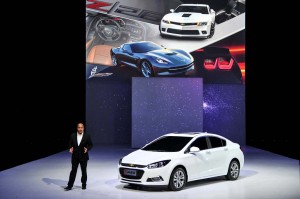For General Motors, the Beijing Auto Show brings both some good news and bad: on the positive side, the Chinese market continues to defy skeptics who worry the country’s economy is cooling – but the downside is that the U.S. maker is now struggling in second place, behind German rival Volkswagen AG, after years as the sales leader in the world’s largest automotive market.
That’s something GM doesn’t take lightly, the company’s second-in-command, President Dan Ammann, using the Beijing Auto Show to announce yet another major expansion plan.
Expect to see GM boost its capacity in China to 5 million new vehicles annually as it pushes ahead with an aggressive $12 billion expansion plan that includes the construction of four new assembly plants and a new engine plant over the next two years.
“China has been GM’s largest market since 2010, last year accounting for about one-third of our global sales,” said Ammann, noting that China is expected to remain the company’s largest market well into the future.
“We don’t see growth in China slowing down,” added Ammann, who said new vehicle sales in China could total 33 million units in 2020, which would be nearly double the size of the U.S. market and roughly equal to the total new vehicle sales of the entire world back in 1971.
(GM unveils both the new Chevy Trax and Cruze models in Beijing. Click Herefor more.)
Ammann said GM and its Chinese joint ventures have performed well as the country’s auto market has continued to expand, and that GM today has an aggressive strategy for capitalizing on the abundant opportunities now and beyond 2020.
(Japanese automakers go all-out in Beijing. Click Here for the story.)
Matt Tsien, who was recently promoted to the newly created post of president of GM China, said, “GM is focused on moving full speed ahead by strengthening all key areas of our business.”
Tsien said GM’s China joint ventures will make capital expenditures of about $12 billion between 2014 and 2017. The investment will help GM step up its pace by funding facility and capacity expansion and new product programs, he said.
Part of the new investment will pay for the introduction of 60 new and upgraded vehicles coming to market through 2018. GM’s focus will be on answering the growing demand for luxury vehicles, SUVs, multi-purpose vehicles (MPVs) and smaller passenger cars.
During 2014 alone, GM China is launching the new Cadillac CTS midsize luxury sedan, two new SUVs – the Chevrolet Trax – and a new midsize entry from Buick), the Baojun 730 seven-seat family vehicle and 610 hatchback, upgraded versions of the Buick Enclave and GL8 as well as a next-generation Chevrolet Cruze, Tsien said.
Investment also will include the opening of five new manufacturing facilities by the end of 2015. With additional facility expansion between 2014 and 2020, GM China’s manufacturing capacity will increase by 65 percent.
Ray Bierzyinski, executive vice president of SAIC-GM-Wuling, said GM also is continuing to expand its presence in the central and western regions of the country. These areas already represent about 45% of GM’s domestic sales. GM will add dealerships and manufacturing by adding new Wuling assembly plants in central and western China as part of the expansion plan now underway. The new assembly plants in these regions, including plants in Wuhan and Chongqing , will be ready by the end of 2015.
Ammann also said during the GM China press conference that GM was comfortable with the joint venture structure that requires western automakers, such as itself and Volkswagen, to operate under restrictions set down by the China’s central government.
“It’s hard to argue with the restrictions that have been in place,” he said.
Between them, GM and VW now control nearly 30% of the Chinese market. The German maker took the sales lead last year and is expected to make some major investments of its own to stay the Chinese king-of-the-hill. For one thing, it announced at the Beijing show an investment plan that will generate $27 billion for upgrading its battery-based vehicle program. Faced with endemic air pollution problems, China wants to see the industry shift, as much as possible, to zero-emission vehicles.
(Click Here for more on VW’s big plans for China.)
Whether GM can regain the sales lead anytime soon is far from certain.
Paul A. Eisenstein contributed to this report.


